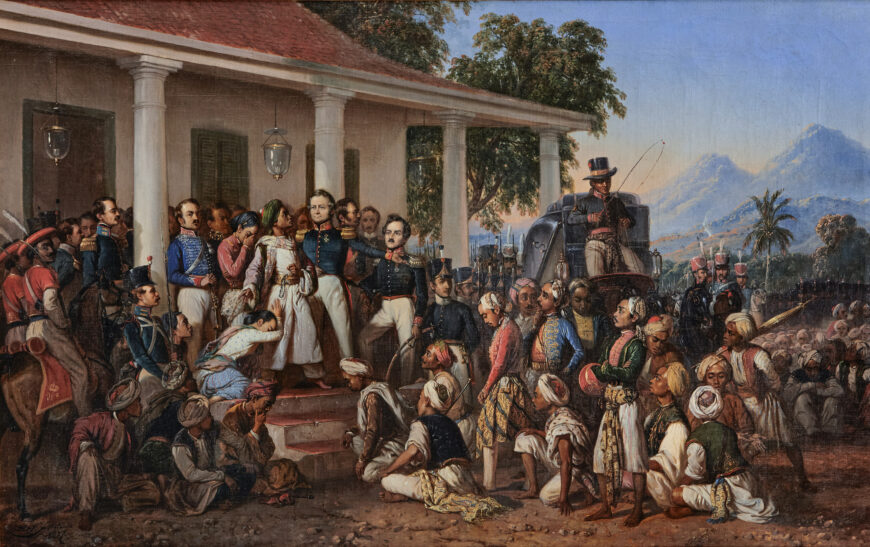
Raden Saleh Syarif Bustaman, Penangkapan Pangeran Diponegoro (The Arrest of Prince Diponegoro), 1857, oil on canvas, 112 x 179 cm (Yogyakarta Presidential Palace Museum)
Historical context
The Arrest of Prince Diponegoro (Penangkapan Pangeran Diponegoro) is arguably the most celebrated painting in Indonesia today. The painting by Raden Saleh depicts a watershed moment in the life of the prince when he was captured by the Dutch colonial army on March 28, 1830.
Diponegoro was the oldest son of the sultan of Yogyakarta (a state within modern Indonesia located in the central part of Java island). Nonetheless, he was passed over for the throne multiple times. Away from the court, Diponegoro focused on his Islamic studies and became increasingly aware of how the Dutch had reduced the sultan’s power while lowering royal income through a series of oppressive colonial policies. In 1825 he took up arms against the injustice and gained considerable support from royals and villagers. Prince Diponegoro and his supporters had some success in the war (known today as The Java or Diponegoro War), though in the end hundreds of thousands of Javanese died for the cause of freedom from colonial oppression.
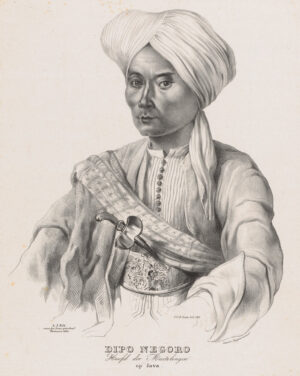
Carel Christiaan Antony Last, after Adrianus Johannes Bik, Portrait of Diponegoro (Dipo Negoro, Head of Mutineers in Java), 1835, print on paper, 49 x 35 cm (Rijksmuseum, Amsterdam)
The Lieutenant Governor-General of the Dutch East Indies (General H.M. de Kock) offered Diponegoro a peace agreement to end the war. Unbeknownst to Diponegoro, however, the invitation was only a ruse to lure him out of hiding. In March 1830, the Dutch army captured Diponegoro who was then exiled to Makassar on the island of Sulawesi where he died in 1855.
Recognizing Prince Diponegoro’s significance in both Dutch and Javanese history, Raden Saleh decided to memorialize the historical moment of the prince’s capture in a painting. It took three years to finish, and once completed, he presented the painting to his most-distinguished patron, King Willem III of Holland. The painting remained in the royal collection of the Netherlands until the mid-20th century.
In 1978, upon request from the government of Indonesia, the painting was returned and now resides in the Palace Collection (Koleksi Istana Kepresidenan Republik Indonesia) in Gedung Agung, Yogyakarta. In 2014, it was officially enlisted as part of Indonesia’s national heritage. Today, Diponegoro is one of the most honored national heroes of Indonesia. His fight against colonial power is memorialized through the ubiquitous production of his statues in multiple public spaces, particularly on the island of Java. His arrest is often used as an emblem of colonial treachery, which continues to be employed to instill nationalism in the younger generation.
The painting
The painting strikes a somber feeling by depicting an orange light at the horizon against a clear blue sky. At the center of the painting, Diponegoro is depicted in white robes and a green turban while standing on the steps of the Residency House of Magelang—where the deceptive negotiation is taking place. His defiant stance is framed by the Dutch military officers that surround him. The person on Diponegoro’s left, looking at the viewer and whose left arm points to a carriage, is Governor de Kock. The carriage signifies the imminent exile of Diponegoro. On the ground, some of the prince’s followers kneel before him. Those standing are either looking down or looking ahead forlornly, recognizing their defeat.
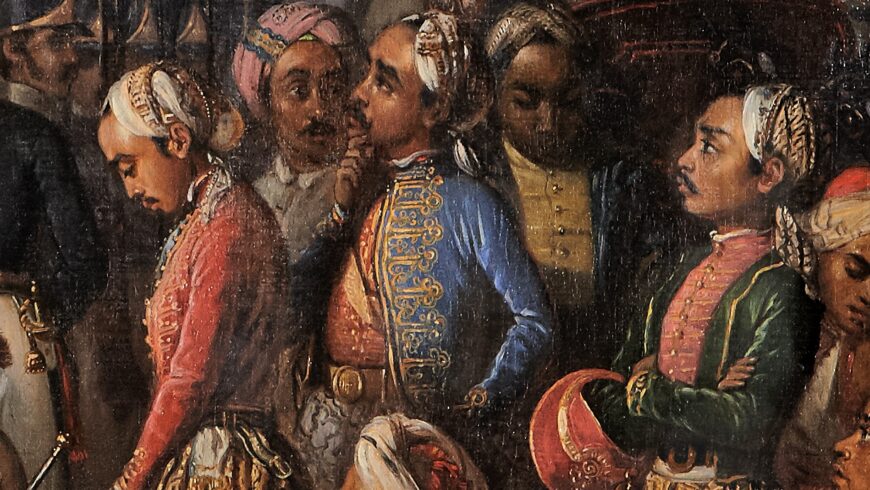
Self-portraits (detail), Raden Saleh Syarif Bustaman, Penangkapan Pangeran Diponegoro (The Arrest of Prince Diponegoro), 1857, oil on canvas, 112 x 179 cm (Yogyakarta Presidential Palace Museum)
Self-portraits
The painter, Raden Saleh, has cunningly inserted himself into the painting as three of Diponegoro’s followers standing on the right side of the painting in front of the carriage. The first self-representation is shown nearest to Diponegoro’s arrest with a figure wearing a white and brown cap, in a red jacket, and a white-brown patterned sarong. This figure is looking downward, perhaps in respect to Diponegoro while contemplating the somber event. The second self-representation looks straight at the unfolding arrest with his left arm bent at the waist while his right hand touches his chin. This figure wears an unbuttoned royal blue jacket with gold embroidery. Saleh’s third appearance depicts him wearing a brown cap, a green jacket over a red top, and a white sarong that is decorated with white-brown patterned drapery. Historian Peter Carey argues that these multiple self-insertions are an indication of Saleh’s admiration, respect, and sympathy toward Diponegoro’s actions against Dutch colonial power.
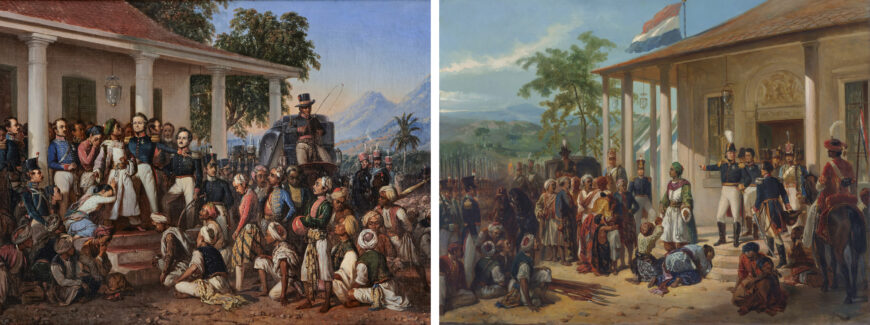
Left: central composition (detail), Raden Saleh, Penangkapan Pangeran Diponegoro (The Arrest of Prince Diponegoro), 1857, oil on canvas, 112 x 179 cm (Yogyakarta Presidential Palace Museum); right: Nicolaas Pieneman, De onderwerping van Diepo Negoro aan luitenant-generaal baron de Kock (The Submission of the Rebel Leader Diepo Negoro to Lieutenant General Baron De Kock), c. 1830–35, oil on canvas, 77 x 100 cm (Rijksmuseum, Amsterdam)
Even though Saleh never stated explicitly that the painting was executed in response to an earlier work of the same subject by an artist from Holland, Nicolaas Pieneman, the comparison is useful. Pieneman’s painting is entitled The Submission of the Rebel Leader Diepo Negoro to Lieutenant General Baron De Kock. Both paintings contain similar elements, including the figures of Diponegoro, de Kock, a group of Dutch army corps, a band of Diponegoro’s followers, and a horse carriage. However, comparing the two paintings highlights the sentiment of this historical event from both the Dutch and Javanese perspectives. For example, the Dutch flag flutters above the building in the Pieneman painting; however, the flag is not included at all in the Penangkapan painting. Pieneman’s painting projects an enlightening tone with bright light and clear blue skies, contrasted with the dark atmosphere of Saleh’s painting. It seems clear that Pieneman presents a historical moment of Dutch and colonial victory whereas Saleh presents the lie which led to Diponegoro’s arrest.
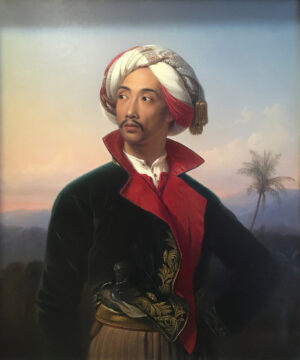
Johann Karl Bähr, Portrait of Prince Raden Saleh Syarif Bustaman, 1842, oil on canvas, 85 x 70 cm (Latvian Museum of Foreign Art, Riga)
The artist and his subject
While there is no written record of his birth date, it is believed that the artist, Raden Saleh, was born to a local aristocratic family on the northern coast of central Java around the late 1810s or early 1820s. His father served as a local regent in Terboyo, enabling the younger Saleh to be recognized by colonial patrons. Early in his childhood, Saleh was ordered to move to Bogor in West Java and to study under the apprenticeship of Belgian painter and naturalist Antoine A. Payen. At the time, Payen was on the island of Java by order of King Willem I of the Netherlands to document, in paintings, the island’s geography.
Supported by the Dutch government and the Minister of Colonies, Saleh spent his formative years in Europe sharpening his skills under various painting masters. He arrived in Europe in 1829 and, for the next 25 years, managed to tour Holland, Germany, France, Belgium, England, and Italy. Throughout those years, he developed expertise in portrait and landscape painting. Using the “Eastern prince” persona, he succeeded in gaining patronage from many European nobles. This is memorialized in his tombstone, in Bogor, listing the royal orders from Holland, Luxemburg, Austria, Saxony, and Saxe-Coburg.
Back in Java, he cleverly used his artistic skills to gain access to both high colonial officials and local elites. He also began to develop interests in other learned fields, including museology, zoology, and paleontology, while breaking boundaries between the presumed images of savage natives and enlightened Europeans in 19th-century Java.
Art historian Werner Krauss has argued that familial and anti-colonial impulses drove Saleh to paint the scene of Diponegoro’s arrest. Saleh’s family were known supporters of Diponegoro during the Java War, in fact this support resulted in Saleh’s father and brother’s exile in 1825. Anti-colonial sentiment was very likely the primary reason Saleh depicted the historical scene of Diponegoro’s arrest. As described above, Saleh shows his sympathetic view towards the anti-colonial cause by portraying Diponegoro more defiantly, even when placed under the custody of the Dutch army.
Before the return of the painting to Indonesia in 1978, Saleh seemed to occupy an ambiguous position within the art history of Indonesia. There was an uneasiness in recognizing Saleh as the earliest “Indonesian” artist because of his proximity to the 19th-century colonial establishment. In 1946, Sudjojono, regarded as the father of modern Indonesian art, questioned Saleh’s allegiance to colonial power. In 1976, Indonesian art critic Harsja W. Bachtiar equated Saleh’s many European patrons with the relationship between native servants and colonial masters. Nonetheless, the return of the painting to Indonesia has generated a more appreciative view of Saleh and his work. His portrayal of Diponegoro in this painting has been offered as hard evidence of his anti-colonial view and enabled Saleh to be solidly positioned as the pioneer of modern art in Indonesia.
Additional resources
Panggah Ardiyansyah, “Restitution and National Heritage: (Art) Historical Trajectories of Raden Saleh’s Paintings,” Returning Southeast Asia’s Past: Objects, Museums, and Restitution, edited by Louise Tythacott and Panggah Ardiyansyah (Singapore: NUS Press, 2021), pp. 163–86.
Peter B.R. Carey, “Raden Saleh, Dipanagara and the Painting of the Capture of Dipanagara at Magělang (28 March 1830),” Journal of the Malaysian Branch of the Royal Asiatic Society, volume 55, number 1 (1982), pp. 1–25.
Werner Krauss, “Raden Saleh’s Interpretation of the Arrest of Diponegoro: an Example of Indonesian “proto-nationalist” Modernism,” Archipel, number 69 (2005), pp. 259–94.
Werner Kraus and Irina Vogelsang, Raden Saleh: The Beginning of Modern Indonesian Art (Jakarta: Goethe-Institut, 2012).
Amir Sidharta, “Indonesian Views of Raden Saleh,” Between Worlds: Raden Saleh and Juan Luna, edited by Russel Storer (Singapore: National Gallery Singapore, 2017), pp. 54–65.

